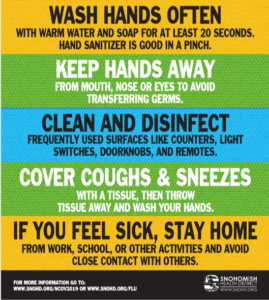FREQUENTLY ASKED QUESTIONS: NOVEL CORONAVIRUS 2019
(Updated March 3, 2020)
1. WHAT IS A CORONAVIRUS? A coronavirus describes a large number of viruses that usually cause mild respiratory illness. But there are coronaviruses that have caused more severe illness, such as severe acute respiratory syndrome (SARS) and Middle East respiratory syndrome (MERS). Novel coronavirus 2019 is a new coronavirus and can cause pneumonia. Other terms you may see used to name this virus include: COVID-19, SARS-CoV-2, or 2019- nCoV.
2. WHAT ARE SYMPTOMS OF CORONAVIRUS? This is a respiratory illness. Symptoms include cough, fever, and/or difficulty breathing. The degree of severity of these symptoms varies. This disease can cause pneumonia. There have been deaths from this illness. However, most cases (80%) do not appear to be severe. People may experience symptoms similar to a cold or the flu.
3. WHERE DID THIS VIRUS COME FROM AND HOW IS IT SPREAD? Like MERS and SARS, COVID-19 closely resembles coronaviruses found in bats but not humans. Scientists believe that the bat virus had a change in its genes that permitted it to spread to humans, possibly via an intermediate carrier (snakes) in an animal market in Wuhan, China. Early on, it is difficult to know the exact source of the virus, how well it spreads from person to person, and how severe the infection is. The virus can be transmitted from person to person via droplets that come from the nose or mouth when we cough or sneeze. Those droplets can directly enter the nose, mouth or eyes of a person standing close by, or they can be indirectly transmitted by hands and inanimate objects.
Human coronaviruses most commonly spread from an infected person to others through: the air by coughing and sneezing, close personal contact like shaking hands, or touching a surface with the virus on it and then touching your mouth, nose or eyes before washing your hands.
4. WHAT ARE RISKS FOR GETTING THE VIRUS? The potential public health threat posed by COVID-19 is high, both globally and to the United States. However, individual risk is dependent on exposure. The risk to the general public of becoming infected appears to be increasing based on this recent discovery of cases that are not immediately linked to travel, but is not considered high at this time.
People who have traveled from an affected country or geographic area in the last 14 days or who are close contacts of someone with a confirmed case of the 2019 novel coronavirus are at higher risk. There have been cases that appear to be transmitted within the U.S. rather than linked to travel, including one presumptive positive case currently being investigated in Snohomish County in a student at Jackson High School.
There are travel alerts for China, South Korea, Japan, Iran and Italy. The list of countries with coronavirus-related alerts may change and people are encouraged to check CDC travel alerts at https://wwwnc.cdc.gov/travel/notices. Travelers from affected areas are advised to self-monitor for 14 days and, if they develop symptoms like a fever, cough or difficulty breathing, to self-isolate and seek medical guidance by calling their health care provider. Contacts of presumptive positive or confirmed cases in Snohomish County are being contacted by public health and are asked to stay home, away from others and self- monitor for symptoms, as well.
The federal government on February 29 announced additional travel restrictions for Iran and additional screening for travelers returning from South Korea and Italy. Restrictions and screenings already were in place for travelers from China. The situation around travel may change quickly as the response to this virus evolves.
Any directives for quarantine or exclusion above and beyond the federal guidance between returning travelers and organizations or institutions with which they interact (like schools or employers) is a matter between those entities. In general, the Health District defers to those parties on resolving conflicts.
This is an evolving situation and the District’s role and guidance may change (sometimes rapidly) with the passage of time, a change in circumstances, and/or release of updated guidelines from DOH and CDC.
5. HOW MANY COVID-19 CASES ARE THERE IN SNOHOMISH COUNTY? There have been six cases as of 11 a.m. March 3. That number may change quickly. We will start providing daily updates on our website at http://www.snohd.org/ncov2019. Updates will be posted by 4 p.m. Cases that are reported after that time will generally be included in the next daily update.
The tally of confirmed or presumptive positive cases is not the full picture. There are likely additional cases who do not have symptoms or have mild symptoms, similar to a cold or the flu, and have not been identified through testing. Although this illness can be severe, the majority of cases appear to be mild or moderate





March 3, 2020
Everett